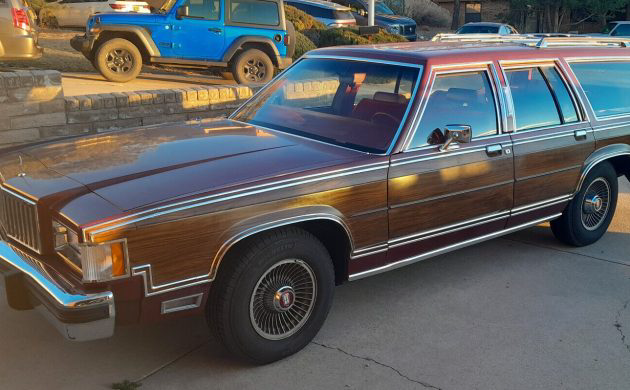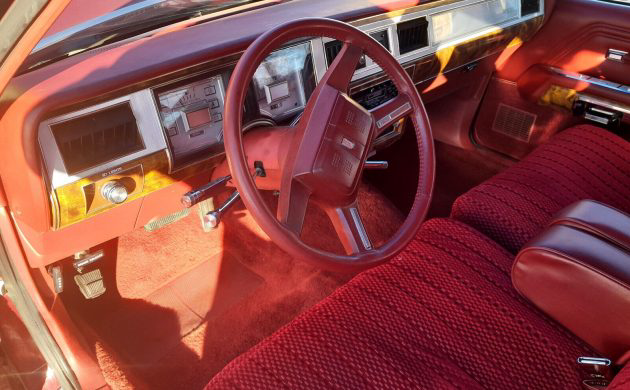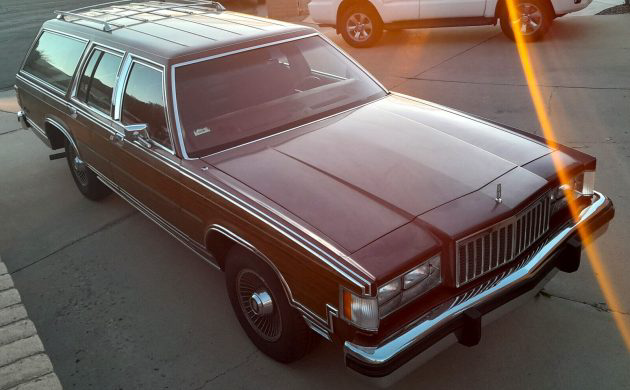
Domestic manufacturers ceased Station Wagon production years ago, citing a lack of interest from potential buyers and plummeting sales volumes. However, that was good news for current owners because those vehicles suddenly gained traction in the classic market. Not everyone wants an SUV, so they must either purchase an import or get their hands on something older to satisfy their needs. The strength of Station Wagons is demonstrated by this 1986 Mercury Grand Marquis Colony Park. It presents well for its age, offering the versatility of third-row seating. Bidding has been quite spirited since the seller listed the Mercury here on eBay in Albuquerque, New Mexico. It remains below the reserve at $6,365, with time remaining for interested parties to pursue it further.

Mercury introduced the Colony Park to its line-up in 1957, with the Sixth Generation becoming part of the Grand Marquis range in 1979. The latest model sold in relatively low numbers, with sales volumes dropping steadily by the time our feature Wagon rolled off the line in 1986. It presents nicely for a survivor, with its Midnight Canyon Red paint holding a pleasant shine. There are no significant flaws or defects, and the faux woodgrain has avoided the worst of the deterioration that is typical with age. The only apparent panel defects are minor dents in the driver’s door, and there are no signs of rust. The wheels, particularly the fronts, look stained from brake dust, although concentrated work with a high-quality polish might have a positive impact. The chrome looks particularly nice, with the roof rack a practical inclusion. There are no glass issues, and while it isn’t showroom fresh, this Colony Park should still attract attention due to its tidy overall presentation.

This Wagon’s interior throws us a curveball with the trim combination. The front seat sports a cloth cover, while the back and third-row wear leather. The seller doesn’t mention a change in their listing, but I can’t locate information suggesting it might be a factory option. Therefore, I must rely on our knowledgeable readers to provide an answer. The overall condition is extremely good for a family Wagon, suggesting the vehicle has been treated respectfully. There are no signs of abuse, with the dash and pad avoiding UV damage. The seller replaced the air conditioning system, but it recently stopped blowing cold. It requires further investigation, although it and an intermittent fault with one back window are the only identified functional issues. It features the creature comforts a buyer might expect from a luxury wagon. The new owner receives power windows, power locks, a power tailgate release, power seats, cruise control, a tilt wheel, and an AM/FM radio/cassette player.

Ford entered the 1980s focused on improved fuel economy in the face of rising oil prices. This approach applied to its Mercury brand and the Colony Park demonstrates the profound change in thinking. Large capacity V8s were consigned to history, and by 1986, the sole available powerplant was the fuel-injected 5.0-liter unit producing 160hp and 280 ft/lbs of torque. Shifting duties fell to a four-speed automatic transmission, while power assistance for the steering and brakes was standard fare. The days of the “Muscle Wagon” had been and gone by 1986, although this vehicle will offer respectable performance. The seller confirms that they and the previous owner have ensured the Mercury is in excellent mechanical health. It has new catalytic converters, shocks, plugs, plug wires, and Michelin tires and is serviced regularly. The seller doesn’t get behind the wheel often, so it needs a new home. They don’t state it expressly, but this Colony Park seems a turnkey proposition for its new owner.

When manufacturers release a vehicle of any description, they typically undertake modeling to determine the sales volumes required to generate a profit. For niche marques like Ferrari, those numbers are usually low. More mainstream companies accept that the profit margins will generally be lower, but these are offset by greater sales volumes to improve the bottom line. I suspect this may have caused Mercury a few headaches with the Sixth Generation Colony Park because its annual total rarely climbed into five-figure territory. Only 9,891 vehicles rolled off showroom floors in 1986, with that total plunging in the following years. The company pulled the plug at the end of 1991, retiring a badge that had served it admirably for decades. This Mercury is a tidy survivor ideal for an enthusiast with a growing family. It is incredibly versatile and should cruise effortlessly for hours on end. If you want a comfortable classic perfect for hauling the whole tribe on a cross-country family vacation, this Colony Park deserves a close look.

$6365 is $2365 more than I think it’s worth 5 digit odometer possible roll over unless you can document it. Overall nice clean car
Oh boy! What a beauty.
Amen!
Nice looking wagon, love the colors. But NEEDS whitewall tires!
Do NOT turn this into another Griswold Family Truckster clone!!!
You think you hate it now, wait till you drive it!
What is that supposed to mean? The Ford Panther platform cars are some of the nicest driving cars ever built! That being said, needs WW tires badly and seats were redone incorrectly.
Salesman’s line from the movie
Once had 83 Grand Marquis 2 door. Sometime later had 2005 Grand Marquis LS. Both great cars. Current 2007 Town Car Signature Limited is the last gasp of traditional American Luxury, never to be built again. FMCs biggest mistake (with possible exception of EDSEL) was dropping Crown Victorias, Grand Marquis, and TOWN CARS!
I had three County Squires, and I loved them all!
The front seats look as if they’ve been recovered in cloth and were probably leather originally. The cloth used in the grand Marquis/Colony Park was velvety and the folding arm rests had the same fabric. It’s also missing the map pockets on the rear of the front seats.
The cloth front seat is not an original Fomoco trim pattern, the pleats along the back of the backrest aren’t anything an OEM at the time would’ve done. Cloth front seat only as a factory option was only ever a Buick thing AFAIK, but third-row seats on wagons from this era were pretty much always vinyl.
The original mileage may be a stretch as the velour material in these cars and the GMs wear like iron and seldom need recovered. There is a sedan at the u pull it right now and the inside looks brand new. Otherwise I love it. Once a common sight on the highways and byways. These like many other things have mostly disappeared. They were wonderful driving cars. I drove a few that were owned by folks I knew.
This thing with a 347 short block, GT40 heads, and an Explorer intake would be practically unnoticeable, and give this thing all of the power it needs. Better upgrade that transmission though.
“Seven” seater ? Depending on whether it has the third row seat, it would either be a 6, 9 or 10 with dual-facing rear seats.
I drive a 1988 Mercury Grand Marquis four-door sedan, with 370,000+ original miles. Mine has silvery-grey velour seats which still do not look worn. These cars are a dream to drive, if you like smooth, solid, comfortable and steady. I used to have white walls on mine — but, try to FIND them now! There are pesky issues with the car — nothing major. Electric door-locks and power window motors cause “headaches”. The driver’s side wiper-arm is an issue. The cruise-control quit, and no-one can seem to fix it. Every now and then the seat-belt/door-agar bonger goes off unexpectedly, and I have to open the driver’s door and shut it, to stop the bongs. The cassette plays out of only one channel, but the radio still plays out of both (A.M. reception never was all that great, and it’s no worse or better now). The air-conditioning, however, still blows ice-cold. No rust issues — and I live in snow-country and drive it all winter. Keeping it clean works on that (come to think of it, have you ever seen one of these that’s a rust-bucket?). The drive-train is getting “tired”, but still uses no oil (probably has about 110 horses remaining now); but it can’t get out of its own way, sometimes, particularly when needing to accelerate at about 35-45 M.P.H. on an uphill grade. Then again, at my age, neither can I! If I had the money, I would like to have an ’86 Colony Park (didn’t care for the ’88 face-lift on the Merc., though it improved the Crown Vicky). And I would like to find one with the ANALOGUE clock! There are 2 other Grand Marquis (both ’86s), and one ’79 Colony Park, all within one mile of me m, and driven daily — and these are not exactly extinct on the roads, either. They ran a fleet of ’82 Grand Marquis as taxicabs locally, until around 2006. I still remember Tenafly, New Jersey and their grey 1953 Buick cabs: some cars you can DO that to. But for me, if I can save the funds, it’s getting time to find a less USED 1980s luxury car. I’d also love to have a 1960 Edsel (which was essentially a Galaxie with altered trim and sheet-metal) — and the like 1960 and 1962 Fords and Mercurys were almost the same (I left the ’61s out, because they were ugly-looking (sorry). But all of those cars were about the same. Edsel, incidentally, was a fine car — nothing wrong with it, except for the late Robert McNamara personally hating the car, and some at Ford not fond of a car bearing Edsel Ford’s name. Much is made of the “love it or hate it” styling — but, in the context of 1957-’58, it was easy to get used to, and even to like. The Edsel had other issues working against it. Failure to establish a good network of dealers early-on was one problem: when you wanted one, you had to go 80 miles to find a dealer! Another issue was, Ford changed their body-shells for 1959, leaving the Edsel with a problem. They already had taken the lovely ’57 Fairlane and totally uglified it for ’58, when just a very slight face-lift would have worked much better. But by early-to-mid 1958, the Edsel styling had caught-on. But then for ’59, they tried to use the original Edsel cues on the all-new ’59 shell, and the result was ungainly to say the least. It probably didn’t help Edsel, that the all-new ’59 Ford was such a thing of beauty (rather hurt the ’59 Mercury also). The 1960 Edsel was a,hasty disguise of the ’60 Fairlane; though this time, the Edsel looked much nicer than its Ford cousin. But it was too late: McNamara had pulled the plug before the hapless 1960 Edsel even had a chance. However, lest we forget, Fords of that era were fine cars — and the Edsel no less so.